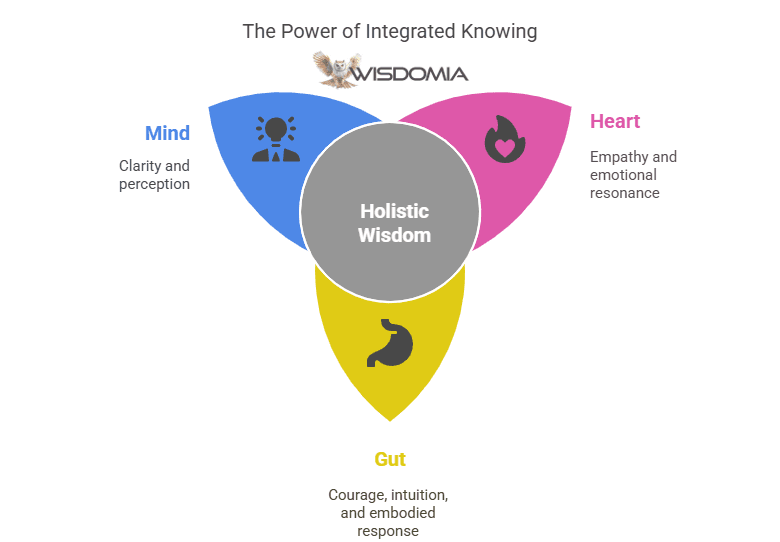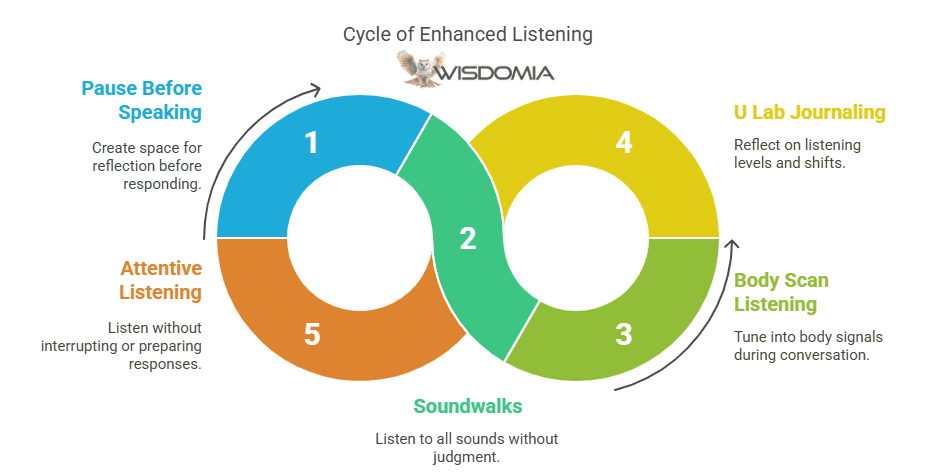The Psychology of Listening: How to Deepen Our Listening
Maria Fonseca
Tue Jul 01 2025

In a world overflowing with noise, the quiet art of listening is both radical and necessary. We live in a time where words come fast and easy, but the space to truly be heard—and to truly hear—is rare. Yet to listen, really listen, is to touch the mystery of connection. It is to move beyond surface sound into presence, meaning, and transformation.
In a world overflowing with noise, the quiet art of listening is both radical and necessary. We live in a time where words come fast and easy, but the space to truly be heard—and to truly hear—is rare. Yet to listen, really listen, is to touch the mystery of connection. It is to move beyond surface sound into presence, meaning, and transformation.
Listening begins with sound waves entering the ear, but its real work unfolds in the spaces between stimulus and response—in the mind, yes, but also in the heart and the body. It is a full-bodied, full-being act. One that, when practiced deeply, becomes a path toward empathy, healing, and wisdom.
More Than Hearing: The Hidden Work of Listening
We often assume listening is passive: the mere reception of sound. But from a psychological standpoint, it’s a deeply active process. Our brains filter and interpret what we hear, often subconsciously. But the psychology of listening tells us that listening is actually shaped by emotions, memories, and expectations. These shape our perception. We hear not only with our ears, but with our history.
According to psychologist Erich Fromm, real listening is an art form. In his beautiful reflection The Art of Listening, he writes:
“Listening is an art like the understanding of poetry... It demands of the listener an inner quietness, a heightened awareness, and a suspension of self.”
In this sense, listening becomes less about information and more about relationship. Not just with others, but with our own inner landscape.
The U Lab Levels of Listening: Mind, Heart, and Gut
Otto Scharmer, in his work with the U Lab and Theory U, identifies four progressive levels of listening. His framework helps us navigate modern life, where constant noise and information overload impact the quality of our attention and presence. Each level of listening, as he describes it, opens a different dimension of our intelligence and deepens our capacity to connect—with ourselves, others, and emerging possibilities.
Downloading – We hear only what confirms what we already know. This is the mind stuck in the past, operating from habitual thought patterns.
Factual Listening – We begin to notice new information that challenges our assumptions. This activates the analytical mind—open, curious, alert.
Empathic Listening – We move beyond data and logic to feel what the other feels. Here, the heart opens. We sense the emotional field between us.
Generative Listening – We listen from the whole self—mind, heart, and gut. We drop into what Scharmer calls presencing: the ability to connect to the emerging future, not just the past.
This final level, generative listening, is not just about others—it’s also about listening to life itself. When we tune in deeply, we access what Indigenous traditions might call the “knowing field,” where intuition (gut), compassion (heart), and clarity (mind) converge.
Deep Listening: A Sonic Meditation
Composer and sound pioneer Pauline Oliveros took listening to the level of art and ritual. Her concept of Deep Listening was not just about appreciating sound, but about cultivating an expanded awareness through it. She defined it as:
“Listening in every possible way to everything possible to hear, no matter what one is doing.”
Through her sonic meditations and soundwalks, Oliveros invited people to dissolve the boundary between inner and outer sound. To listen not only to music or speech, but to silence, breath, space, and the unexpected. Her work taught that sound can be a doorway—not only into the world, but into the self.
Oliveros understood listening as a fundamentally embodied and relational act. She invited listeners to attune not just with their ears, but with their entire nervous system. In group deep listening sessions, participants practiced co-regulation—allowing their breathing and awareness to sync with one another through sound. This created what she called “expanded consciousness,” a collective field of perception where sound, silence, and presence fused into a kind of communion. In this way, deep listening becomes both a meditative practice and a social technology—one that reawakens our connection to ourselves, to one another, and to the living environment.
Listening as Love: Thich Nhat Hanh and the Compassionate Ear
If Pauline Oliveros brought listening into the realm of art, Zen master Thich Nhat Hanh brought it home to the heart. He spoke of deep compassionate listening as a form of service, a healing act that has the power to relieve suffering.
“You listen with only one purpose,” he wrote, “to help him or her to empty their heart.”
For Thich Nhat Hanh, true listening was a practice of interbeing—a recognition that we are deeply interconnected, and that by listening deeply to another, we water the seeds of peace in both of us. This kind of listening asks nothing in return. It doesn’t seek to fix, argue, or control. It simply holds space. It is heart-based, but also rooted in the breath and body. He taught that to listen well, we must also listen to ourselves—with mindfulness and gentleness.
Listening as a Way of Being
What emerges when we bring together these teachings—Fromm’s psychological insight, Scharmer’s levels of listening, Oliveros’ sonic awareness, and Thich Nhat Hanh’s compassionate ear—is a new vision of listening. One that is not just about sound, but about attunement.

To deepen our listening, we must slow down. We must let go of the compulsion to respond, fix, or defend. Instead, we inhabit the space of the unknown—what Scharmer calls “the emerging future.” This requires presence in all three centers of knowing:
The mind, for clarity and perception.
The heart, for empathy and emotional resonance.
The gut, for courage, intuition, and embodied response.
When these are aligned, we don't just hear—we receive. And in that receiving, new possibilities arise.
Practices to Deepen Your Listening

Here are some practices inspired by the wisdom of these thinkers:
Pause before speaking - Notice the silence after someone finishes. Let the space deepen.
Soundwalks - Take a walk and listen to every sound—natural, mechanical, inner, ambient—without judgment.
Body scan listening - While in conversation, tune in to your body. What signals is it giving you?
U Lab journaling - Reflect: What level of listening was I operating from today? Where did I shift?
Listening with attention and intention - When someone speaks, practice listening without interrupting or preparing your response. Just breathe and receive.
The Soul of Listening
To listen is to welcome. It is to open the door of our being to the voice of another—or to the voice within. It requires not only cognitive attention, but emotional presence and spiritual stillness.
In listening deeply, we resist the culture of noise, distraction, and immediacy. We enter into the timeless.
And perhaps, if we listen well enough, the world might whisper back something new—something we didn't know we were waiting to hear.
Further Reading & Resources:
Erich Fromm on the Art of Listening
Thich Nhat Hanh on Listening as Love
previous
Why Do We Forget Future Tasks? The Science Behind Prospective Memory Failures
next
Why Are Plants Green? How Light Absorption Shapes Their Color
Share this

Maria Fonseca
Maria Fonseca is an interdisciplinary educator, writer, artist and researcher whose work bridges the realms of academic knowledge, community engagement, and spiritual inquiry. With a background in Fine Art and a doctorate in creative practice, Maria has spent over a decade exploring the intersections of human experience, cultural meaning, and collective transformation.
More Articles

The Unique Mural Art of Morocco: Exploring the Stories and Symbols Behind the Walls
The Great Barrier Reef: Exploring the Future of Australia's Iconic Marine Ecosystem

Exploring the Future of Transportation: Innovations Shaping Mobility in 2025 and Beyond

Unveiling The Spiritual Significance of the Hawk: Messages from Above

Exploring the Invisible World of Emotions: Understanding Your Inner Landscape





